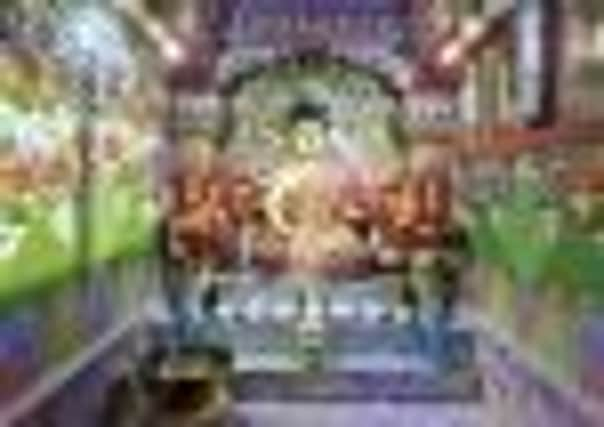The holy shrines celebrated in model sheds


When I arrive at the magnificent 20:21 Visual Arts Centre in Scunthorpe on a perishingly cold Winter’s day, Richard Bartle is up a ladder, sweating profusely as he puts some lights up.
He waves at me to come in, I step into the huge space of the converted church and I’m met by what can only be described as a Shedhenge. A number of exquisite hand-made sheds, each about two feet high, are arranged in a circle on stone plinths and pieces of carpet around the room, and the Scunthorpe sunshine is catching them and making them glow. The space is big, but it doesn’t overwhelm the sheds. Richard climbs down from the ladder and opens one of the shed doors; there’s an altar inside, an altar to the Buddhist faith. A little Buddha is sitting there, shining, and there’s a pestle and mortar and some tiny vessels in a row. Inside the Sikh one there are two lights and a pair of crossed swords, and when you open the door on the pagan shed there’s a rope circle and a broom in the corner. There are twelve sheds in all, from Bah’ai to Taoist, and each one is an amazing feat of construction and care.
Advertisement
Hide AdAdvertisement
Hide AdRichard Bartle is an artist who works out of the Bloc complex of studios in Sheffield, a city that’s fast becoming the art hub of the North, with spaces and galleries and artists at every turn. There are sixty artists at work in Bloc, as well as a gallery for showing their work and touring exhibitions. Perhaps as one economy recedes, another economy grows, and bad times will make for good art.


On one level this is a very simple exhibition; Richard, like many people, has always been fascinated by the shed as a place of refuge, as a place of making, as a place of contemplation. He remembers as a child going to the sheds of relatives.
“The jars of nails on the shelves, the half-built motorbikes, the heaters, the kettles,” he enthuses as he opens another miniature shed door onto a peaceful and simple Protestant altar.
He remembers wiring up a red, green and blue bulb in a box and making a disco in one shed, and holding meetings of his Honda Motorbike Club in another one. He also recalls that the sheds really were sacred places, places of enigma and mystery full of objects that had potent cultural power.
Advertisement
Hide AdAdvertisement
Hide AdThis ‘deities at the bottom of the garden’ idea grew out of that, and Richard’s been engaged on the project for the past three years. Speaking as someone who could never even finish an Airfix Stuka, I find the craftsmanship in the objects quite incredible; each figure, each piece of fruit, each wall-covering, each piece of holy furniture, has been made from scratch, as have the sheds themselves. It would have been easier to buy pieces of ready-made wood or items of doll’s house furniture that could have been customised, but that isn’t how Richard works. He’s part of a proud tradition of South Yorkshire makers, people for whom shoddy workmanship would never do, for whom the swung hammer and the botched job were a weapon of last resort.
Why put the religions in the sheds? Does it diminish them? Richard says it doesn’t, that the exhibition is about the way that we can keep our religion secret, like we used to keep the making of things secret in the shed, that behind an ordinary wooden door you can find the inner life of the shed owner, a life you never knew he had. The pieces are also about the care we take with our symbols, they have to be placed just so by the altar or on the sacred table, in the same way that those jars of screws weren’t to be shifted. In the gallery, as I talk to Richard and become bowled over by his enthusiasm, it begins to seem the most natural thing in the world to place a series of the ritual objects and spaces of world religions in tiny sheds. As I wandered round Scunthorpe’s indoor market, I thought about whether the exhibition might cause offence. After all, if you’re a follower of a particular religion (I’m not) would you be shocked at the idea of everything you believe in being placed in a shed? I came to the conclusion that the answer is No. As an essay in the exhibition’s catalogue says “Deities at the Bottom of the Garden sustains an inquisitive tension between the microcosm of our individual beliefs and the macrocosm of our worldly inheritance. Moving as tourists from one attraction to the other we find ourselves navigating the significance of human creativity and ritual practice.” In other words, it’s okay. There’s celebration here, there’s an acknowledgement of the huge part that spirituality and religion and, yes, ritual play in many people’s lives, and these are some of the best made sheds you’ll ever see.
Ian McMillan’s day in Scunthorpe
The exhibition Deities at the Bottom of the Garden, runs at the 20:21 Visual Arts Centre in Scunthrorpe until February 23.
The café at 20:21 serves the kinds of cake that help you to appreciate the art more fully, in my personal opinion.
Advertisement
Hide AdAdvertisement
Hide AdBloc Projects, where Richard Bartle works and exhibits is at 4 Sylvester Street Sheffield.
The religions in the exhibition are Bah’ai, Buddhist, Catholic, Hindu, Islamic, Jewish, Orthodox, Pagan, Protestant, Shinto, Sikh and Taoist.
Details on 0114 2723155 or 01724 297070.